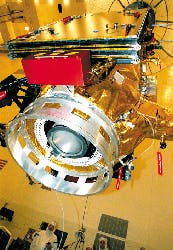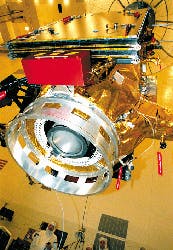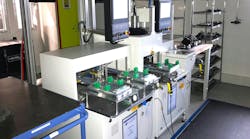Ion propulsion successfully flies on Deep Space 1
By John McHale
CLEVELAND — The successful flight of NASA`s Deep Space 1 spacecraft`s ion engine has NASA engineers confident that ion propulsion will be an efficient alternative to chemical propulsion for future missions to space.
NASA scientists believe the propellant, while relatively slow to accelerate, can last longer and is cheaper to use than chemical propellants. The total ion propellant used may be about 10 times less than would be necessary for a conventional chemical propulsion system — roughly equivalent to having one`s car get 300 miles per gallon, they claim.
This efficiency in turn enables NASA specialists to explore the solar system with small spacecraft and inexpensive rockets, says John Brophy, program manager for NASA`s Solar Electric Propulsion Technology Application Readiness (NSTAR) program team, which developed and delivered Deep Space 1`s ion propulsion system. On DS1, the xenon propellant will increase the spacecraft speed by about 3.6 kilometers — 2.2 miles — per second, he says.
Engineers at what was then called the NASA Lewis Research Center in Cleveland built NASA`s first ion engine in 1960. Since then, there have been many tests of the technology in the laboratory and some limited tests in space. But no mission planners have been willing risk a million-dollar spacecraft on a propulsion system that might not work.
Lewis Research Center was renamed the NASA John H. Glenn Research Center at Lewis Field last March.
NASA`s New Millennium program, which flies several inexpensive missions to demonstrate new technologies, gave ion propulsion its chance to succeed, and the technology proved efficient and performed as expected, Brophy says.
The NSTAR program began in the early 1990s as a partnership between the Jet Propulsion Laboratory (JPL) — a division of the California Institute of Technology in Pasadena, Calif. — and the Glenn Research Center to develop xenon ion engines for deep space missions. Managing Deep Space 1 is JPL for NASA`s Office of Space Science in Washington.
Partners in the development of the flight ion engine system included Hughes Electron Dynamics Division in Torrance, Calif.; Spectrum Astro Inc. in Gilbert, Ariz.; Moog Inc. in East Aurora, N.Y.; and Physical Science Inc. in Andover, Mass.
How it works
Ion propulsion involves ionizing a gas to propel a craft. Instead of using standard chemicals, the gas xenon — a colorless, odorless and tasteless gas more than four and a half times heavier than air — receives an electrical charge. It then electrically accelerates to a speed of about 30 kilometers per second, Brophy says. When the engine emits xenon ions at such high speed as exhaust from a spacecraft, they push the spacecraft in the opposite direction, he adds.
When the ion engine is running, it emits electrons from a hollow bar called a cathode into a chamber ringed by magnets, much like the cathode in a TV picture tube or computer monitor, Brophy explains. The electrons strike atoms of xenon, and knock away one of the 54 electrons orbiting each atom`s nucleus. This leaves each atom one electron short, giving it a net positive charge. This makes the atom an ion.
The engine is basically a hollow can about a foot in diameter, Brophy says.
At the rear of the chamber, a pair of metal grids receives a positive and negative charge respectively, with as much power as 1,280 volts of electric potential. The force of this electric charge exerts a strong "electrostatic" pull on the xenon ions — "much like the way that bits of lint are pulled to a pocket comb that has been given a static electricity charge by rubbing it on wool on a dry day," NASA officials say.
The electrostatic force in the ion engine`s chamber, however, is powerful enough to cause the xenon ions to shoot past at a speed of more than 60,000 miles per hour out the back of the engine and into space.
At full throttle, the ion engine would consume about 2,500 watts of electrical power and put out 90 millinewtons (1/50th of a pound) of thrust, NASA officials say. This is comparable to the force that one sheet of paper exerts while resting on someone`s hand — approximately 10,000 times smaller than the thrust of the main engines on typical planetary spacecraft, they explain. Despite the almost imperceptible level of thrust, this engine, for a given amount of fuel, can increase a spacecraft`s velocity 10 times more than can a conventional liquid or solid fuel rocket, NASA officials claim.
Once converted, Xenon is "an eerie, faint, blue haze visible from the back of the spacecraft" as it moves through space, NASA officials say. Large solar arrays generating more than 2,000 watts power the engine.
The ultimate speed of a spacecraft using ion thrust depends upon how much propellant it carries. The ion propulsion system on Deep Space 1 carried about 81.5 kilograms of xenon propellant, and it takes about 20 months of thrusting to use it all.
It increases the speed of the spacecraft by about 4.5 kilometers per second, or about 10,000 miles per hour. If the same amount of chemical propellant were used, it would provide only one tenth as much velocity increment, NASA officials claim. If DS1 carried a larger solar array, it would have had a slightly higher acceleration, and if it carried more Xenon propellant it could have reached a much higher final velocity by simply thrusting longer, they add.
Ion vs. chemical
Ion propulsion has little value for missions that require high acceleration, and it often will not be worthwhile for missions that can be done quickly using conventional chemical propulsion systems — such as missions to the moon, NASA officials say. But for a wide variety of missions with high-energy requirements — such as missions to asteroids, comets, Mercury, the inner solar system, and some missions to the outer solar system — the low but steady acceleration of ion propulsion wins out over the less efficient bursts from chemical alternatives.
If a spacecraft were to go to Pluto or areas of space where the Sun`s energy is weak, it would need one of two things: either a chemical propulsion system, or enough acceleration while in the inner solar system, where solar energy is abundant, to coast to Pluto.
These studies have shown that trips to Pluto may be accomplished in a few years less than with standard propulsion systems. Depending on the year of launch and the specific assumptions, it generally takes about 10 to 12 years for a chemically propelled spacecraft to reach Pluto, NASA officials explain.
Launched October 24, 1998, Deep Space 1 has validated 12 new technologies, including ion propulsion. Scientists say they can confidently use them during science missions of the 21st century. The project has exceeded all of its technology validation success criteria, NASA officials claim.
The ion engine is proving its worth aboard Deep Space 1.




